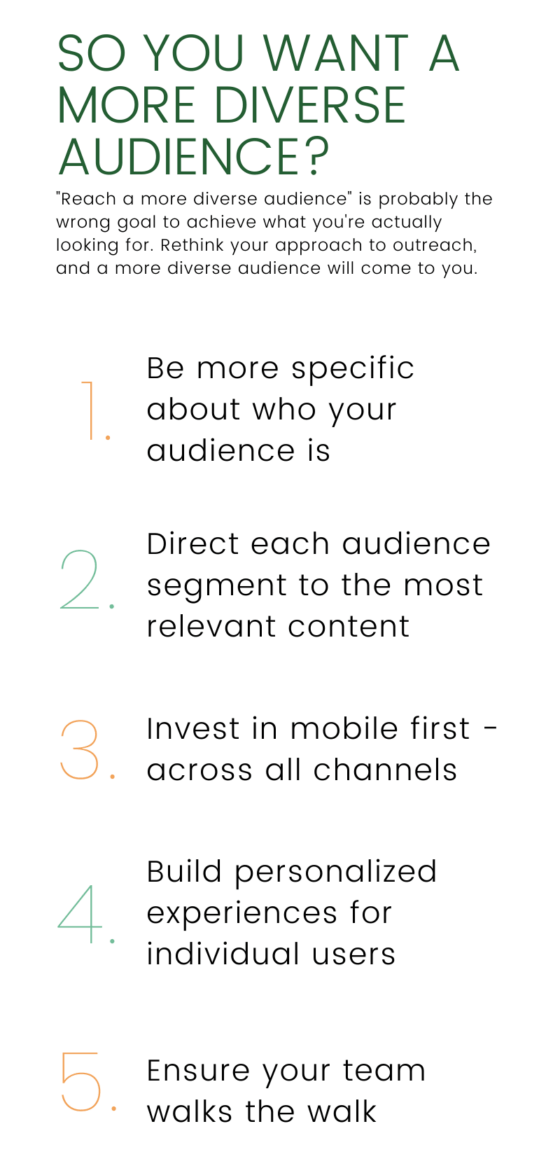“Our audience is too white, too male, too US-centric, too [something].”
“We need to diversify our audiences.”
“How can we attract a more diverse supporter base?”
If you work in nonprofit marketing or fundraising, chances are you’ve heard one of these from a colleague recently. In this “new” era of racial reckoning, many organizations are (rightly) considering who they’re reaching, and who is left out or excluded.
 However, a commitment to making your audiences more diverse is just the start. A vague goal such as “diversifying our audience” often leads teams to tactics like “make our content accessible to the general public.” (I won’t even bother with a blog post on how the general public is not an audience. Too many others have already written about that!) Even worse, you might hear content teams bluntly state: “We need to reach more people of color/Black people/women.” These demands are too generic, at best, and reductive at worst. Unless you’re a racial justice or women’s organization with content broadly applicable to a demographic, it’s best to have more specific goals.
However, a commitment to making your audiences more diverse is just the start. A vague goal such as “diversifying our audience” often leads teams to tactics like “make our content accessible to the general public.” (I won’t even bother with a blog post on how the general public is not an audience. Too many others have already written about that!) Even worse, you might hear content teams bluntly state: “We need to reach more people of color/Black people/women.” These demands are too generic, at best, and reductive at worst. Unless you’re a racial justice or women’s organization with content broadly applicable to a demographic, it’s best to have more specific goals.
With that in mind, how can you actually begin to reach more diverse audiences?
1. Be more specific about who your audience is
This may sound counterintuitive if you’re trying to reach more people, but having narrower segments allows you to better meet audience needs. For example, many think tanks are currently rethinking the role of their content. Amidst broad proliferation of misinformation on social media, reputable research-based organizations are seeking a stronger voice on policy topics. However, this requires reaching beyond the input of those within the “ivory towers” ― traditional think tank audiences of academics and policymakers. However, trying to reach the “public” with “news” likely won’t satisfy anyone.
Instead, these organizations can look at the relevance of particular topics for a target audience. A program on urban education might target content to parents of public school kids. An initiative related to employment policies might best resonate with members of labor unions. Both of these are likely to reach a more diverse audience, not just because it’s a diverse group, but because the content is relevant to their interests.
2. Direct each audience segment to the most relevant content
Many nonprofits are trying to influence legislation and regulation on their issues. However, policymakers and regulators have a range of expertise, and may not have deep knowledge on every topic. To be effective, you need to provide content options that meet each unique user where they are.
 One way to do this is to use the “bite-snack-meal” approach to content. This creates a “menu” of
One way to do this is to use the “bite-snack-meal” approach to content. This creates a “menu” of
content for audiences with different levels of expertise or interest. Consider how to share the results of a research study. You might include:
- a pull quote that makes the study results clear (bite),
- an infographic of the study’s key points (snack),
- and a downloadable PDF of the report (meal).
Now you can reach a research scientist and a teacher looking for easily digestible graphics all based on the same underlying content.
Another approach is to use site navigation to steer people to relevant content – even if that means including similar content in two places. For example, we helped the American Chemistry Council design a header that drives policymakers to one section (“Better Policy and Regulation”), and audiences with less depth of knowledge to content about the impacts on their everyday life (“Chemistry in America”).
Much of the underlying content in these two sections is actually the same (and is organized using strong taxonomy to drive automated content feeds by topic), but is packaged in different ways, relevant to ACC’s various audiences.
3. Invest in mobile first – across all channels
The digital divide is real, and it’s important to consider those who only have access to mobile devices. On average, mobile-only users are younger, lower-income, and people of color. For these demographics to engage with your content, it needs to be just as compelling on a mobile device. Yes, having a mobile responsive website is a big piece of this, but that’s the bare minimum. Driving meaningful engagement with a mobile audience requires a cross-channel approach. You likely aim to drive a portion of your website traffic from emails ― are you testing your email templates for mobile responsiveness? Or have you focused on making them look good in Outlook, because that’s what your staff is using? Social media platforms are also major drivers of content consumption and sharing ― are you investing in those channels? Or simply posting links to content that was created for your website as an afterthought? Make sure you’re allocating budget and staff resources to high quality social media content and email templates.
To take mobile engagement even further, consider whether your content might be useful in an app format, since apps have much higher engagement than mobile or even desktop browsing. Not all content lends itself to this format, but it might be right for you if you have:
- content behind a firewall where users need an account to access it,
- functionality where users can save or bookmark content,
- a recurring conversion like signing petitions or other advocacy,
- forms/requests that users need to fill out and track the status of,
- or a lot of audio/video content.
You don’t necessarily have to create your own app either. Many organizations publish audio/video content to Spotify, YouTube and Vimeo. Third party apps can be strong channels to make existing content discoverable by new audiences.
4. Build personalized experiences for individual users
Now you’ve defined your audiences, created targeted content, and customized content for various platforms. You should consider getting more granular to individual users’ preferences. Personalization pushes the right content, to the right person, at the right time. Delivering personalized content to an individual means you won’t lose users who aren’t drawn in by the first thing they see. However, automated personalization relies on complex underlying processes and technology to work effectively. This requires investment in data, taxonomy, list building, and CRM infrastructure and integrations. This infrastructure captures detailed user preferences, and drives personalized content recommendations.
A first step in planning personalized content is listening to your audiences. Consider the channels where you might capture more information about their interests. These could include:
- a welcome series with targeted interactions aimed at interest-based segmentation;
- a preference center where users can opt in or out of newsletters on various topics;
- a logged-in user experience on your website to learn more about what content is viewed;
- or mining your site search data and social feeds to learn from the language your audience uses when talking about your content.
Once you have a plan for gathering individuals’ preferences, that will guide investments in email, CRM and website platforms.
5. Ensure your team walks the walk
It should go without saying that if you want to attract a more diverse audience, your organization should reflect that diversity. There is plenty of research on how diversity in leadership drives improved organizational performance. However, also consider the makeup of your content team. The voices that create and disseminate your content need to reflect the audiences you are trying to reach.
There are thousands of small decisions that go into your outreach: colors, images and graphics, topic prioritization, word usage, tone, channels, and even the time of day to post content. We all come with implicit biases, but more diverse teams help eliminate blind spots and ensure content reflects a range of perspectives.
In creating content for diverse audiences, it is easy to be well-intentioned, but tone-deaf in your approach. The more homogenous your content team is, the more likely it is that nuances about your audience will fade to the background. Be aware of your limitations as creators, and build a team that reflects the diversity of the audiences you’re seeking to reach.
If you’ve ever asked yourself “How can I reach a more diverse audience?” you’re headed in the right direction. Reach out if we can help you take the next step by building the strategy, content processes, and technical infrastructure to achieve your goals.





